Hermle 8 Day Clock Movement 351-020 23cm Westminster Chime 5 Hammer (WORKS) B4
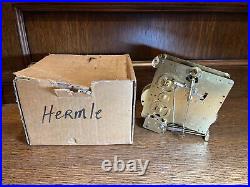
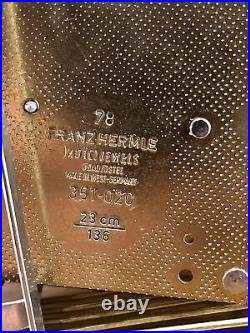
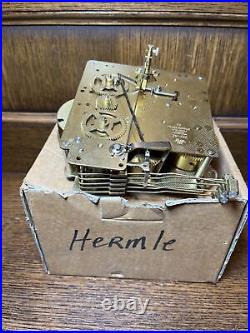
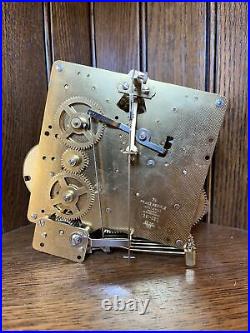
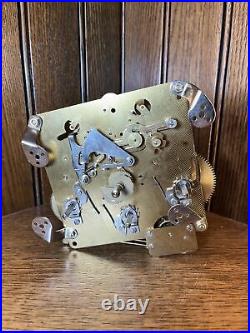
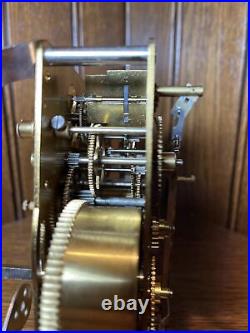
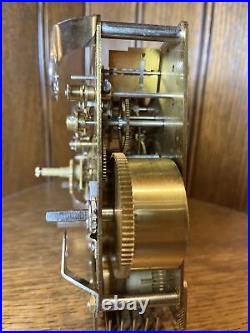
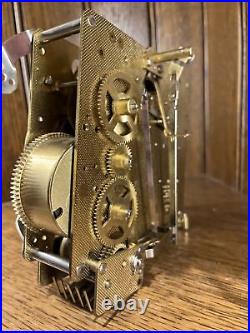
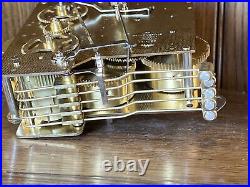
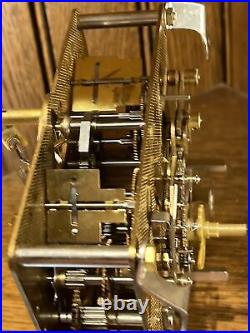
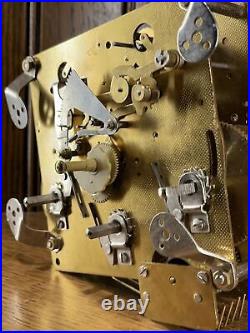
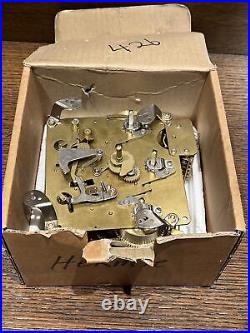

Hermle 8 Day Clock Movement 351-020 23cm. This is an 8 day Westminster chime movement with 1/4 hour chime and hour strike.
Key wound, pendulum regulated and 5 hammers at the bottom. All three springs wind up tight. Flywheel spins and hammers strikes. Please plan on having it cleaned, serviced and oiled before use. This movement is used in Emperor, Howard Miller, Hermle, Sligh, Ridgeway. Seth Thomas, Pearl, King Arthur and many other popular manufacturers: 5 hammers bottom Movement pendulum Spring Driven Made in Germany Plate diameter 120mm x 120mm 8 Day Westminster Chime. Hand Shaft length measures 33 mm.Please note, it is best if you have knowledge of clockmaking or clock movements if you plan to replace this movement yourself. Distance From Center Of The Hand Shaft To Center Of The Winding Arbors Is 1-1/4. Distance Between The Center Of The Winding Arbors Is 1-1/2. The plates measures about 4-3/4" Wide x 4-3/4" Tall The distance between plates is about 1-3/8. Please view all of the pictures before purchasing.
As you will be able to see if it may include the parts needed for your repair or restoration. What you see in the photos is exactly what you will receive. He numbers on the back plate of the 351-020 Hermle Clock Movement is everything one needs to get a replacement.If the numbers match then the movement will match. So if is says 351-020 it will be the correct on. Spring Driven Movements, Hermle, Howard Miller, Ridgeway, Sligh, Emporer, Hamilton, All Products, Clock Movements, Mechanical Movements, Hermle Clock Movements, 350/351 Hermle Clock Movement Tags: 351 020, bottom hammer, key wound, westminster. As you will be able to see if it may.
Include the parts needed for your repair or restoration such as. Anchor Saddle, Escape Gear, Keeper, Crutch, Suspension, Spring, Pendulum, Hammer Rod, Winding Arbor, Count Wheel, Count Lever, Fan Fly, Wheel, Pallet, Jewel, Main Wheel, Mainspring, Barrel, Driving Wheel. We sell clocks to professionals, hobbyists and collectors who have experience in repairs.. If you are just trying to fix a watch or clock without knowledge of how to do so, we suggest that you seek out professional help. This can lead to be an expensive proposition if you should not have the knowledge to repair or restore your clock.
Make sure you join the National Association of Watch and Clock Collectors. Its a great way to meet other clockmakers. This clock movement may also work with other German Clocks including Wall Mounts, Grandfather, Shelf, Column, Ogee, Steeple, Gothic, Acorn, Hump Back, Porcelain, Carriage, Cabinet, Gingerbread, Mission, Seth Thomas, Regulator, Banjo, Gallery, Looking Glass, Lyre, Calender, Cuckoo, Bracket, Behive, Cottage, Scroll, Grecian, Gilbert, Atkins, Iron Front, Waterbury, Parlor, Pedimented, Camel Back, Welch, Ansoniamonarch, Sessions, Chimes, Pendulums, Schatz, Kieningern, Haller & Kundo. Clockmaking, Clockmakers, tools, Clockmaker's, Watchmaker's, Collectors. Clocksmith - someone whose occupation is making or repairing clocks and watches.Clockmaker artisan, journeyman, artificer, craftsman - a skilled worker who practices some trade or handicraft. Restoration, Restore, Repair, Parts, Repurpose Supplies Salvage Hardware Repurposed.
Samuel Abbott, Ansonia Attleboro Bailey Banks & Biddle; Birge, Gilbert Birge, Mallory Birge, Peck Boardman & Dunbar Boardman & Wells Brewster & Ingrahams Bridgeport Chauncey Boardman Chauncey Jerome Chelsea Chicago Colonial of Zeeland David Wood Dyer, Wadsworth E. Howard E & A Ingrahams Elgin Elias Ingraham; Eli Terry E N Welch F Kroeber Franklin General Electric General Time H. Thompson Harris & Mallow, Heman Clark Herschede Hotchkiss and Benedict Howard Miller Jennings Brothers Joyce Bros. Lawson Luman Watson Masterclock Munger and Benedict National Time and Signal New England New Haven Parker & Whipple Pomeroy, Ray and Ingraham Reeves Ridgeway Riley Whiting; Samuel Whiting; Salem Sangamo Self Winding Clock Company; Sempire Seth Thomas Sessions Standard Electric Time Company United Waltham Warren Waterbury Western, Westclox; William L Gilbert Williams, Orton & Preston Wood Art Weursch Elderhorst Bells. Clocks as we know them today, with dials indicating the hour and minute of the corresponding time, originated in medieval Europe and were predominantly installed in churches and town halls. It wasn't until the 19th and 20th centuries that clocks evolved at an exceedingly swift rate, resulting in greater accuracy, more refined designs, and more frequent appearances in people's homes. In both the United States and internationally, astrological, tall-case, year-long runners, and skeleton clocks are in demand. Howard and Seth Thomas are two of the bigger names that collectors are seeking out right now, Buyers of antique and vintage clocks today range from collectors who own hundreds of them, to the retail buyers who've been looking for the right grandfather clock to display in their living room. Collectors pay close attention to rarity and condition, For early American clocks, they look for original glass tablets, original painted dials, and the original finish or actual wood case. With European clocks, specialists tend to be a bit more forgiving in terms of condition because it has more to do with the movements and gears.A replaced gear on a European clock, for example, may be more acceptable than a replaced tablet or dial on an American clock. By the 19th century, recognizable innovations and styles began to emerge across Europe. In France, for example, clocks were fitted with extravagant cases mirroring trends in interior design, and by 1850 carriage clocks decorated with Limoges enamel, porcelain, and gilt metal were becoming exceedingly popular. Meanwhile, Germany specialized in making affordable brass and wooden clocks, most notably cuckoo clocks, which were made in the Black Forest region and exported across Europe. Skeleton clocks were the characteristic choice for British households, churches, and government buildings, as were clocks decorated with Gothic-inspired cases and architectural elements, exemplified most famously by Big Ben.
Antique Vienna and English clocks from 1780 to 1920, the most famous and collectible makers produced clocks between 1700 and 1890. This was the great era of clockmaking, and a time that sparked lots of novelties and inventions in clock movements and cases. Twentieth century clocks typically drew inspiration from earlier styles, although the U.
Made, electrically-powered "Eureka" clock is especially indicative of the years leading up to the First World War. The heyday of clock manufacturing took place in the first half of the century, and by the 1950s clocks became increasingly minimalistic in design, reflecting developments in modern art and architecture. Today, clocks are available at a wide range of prices, styles, and sizes, evidencing the long-lived history of these highly valued, sophisticated timekeeping devices. High-end, valuable clocks tend to be handmade, rare, or limited edition pieces made or decorated with precious materials, such as gold, diamonds, rubies, mother-of-pearl, enamel, porcelain, and high-quality wood. Clocks made by important designers, like Abraham Louis Breguet, or reputable manufacturing companies, like Ansonia, are also highly prized as premium collectible pieces.Wall clocks, which were first made during the 16th and 17th centuries, are among the earliest styles of clocks designed for display within the home. They not only tell time but also serve as sculptural works of art adorning the room. One of the most fashionable styles of antique wall clocks is the Ansonia hanging clock, made by Ansonia Clock Company, which originated in Ansonia, Connecticut in 1851 and moved to Brooklyn, New York in 1878.
Ansonia clocks are usually made of a combination of brass and high-quality wood and decorated with ornately executed designs, such as mini-friezes, classicizing figures, and floral and geometric designs inspired by ancient Greek architecture. Bidermeier clocks, made in Germany and Austria between 1815 and 1848, are another popular type of antique wall clock.
Produced primarily for a burgeoning middle class knowledgable of the value of furniture and interior design, Bidermeier clocks exhibit simple yet elegant features. One of the main identifying characteristics of this refined style is the juxtaposition between the sleek, straight lines of the clock's torso and the delicate curves of the baroque and gothic motifs decorating the upper and lower portions of the case.
Mantel clocks were first made in France and were typically placed above the fireplace alongside vases or sculptural figurines. Also known as chamber clocks, early mantel clocks oftentimes had handles, enhancing their practical function as portable timekeeping devices that could be easily picked up and moved from mantel to bookshelf to tabletop; however, later versions departed from this design. Vintage mantel clocks, especially those made during the Art Deco period and mid-century, are valued today for their simple yet. Cuckoo clocks were first made during the 18th century in the Black Forest region of southwestern Germany, although they also have a long history in Switzerland and Austria. These clocks are of course famous for the automaton cuckoo bird that moves in tandem with musical notes each time the clock strikes the hour.
Cuckoo clocks are prized for their lively, interactive quality and handmade, intricately carved designs. Antique versions are typically decorated with forest and hunting scenes and include animal motifs, most notably hounds, deer, rabbits, pheasants, and other woodland creatures. Grandfather clocks are named after the 1876 song "My Grandfather's Clock" ("My grandfather's clock was too large for the shelf, So it stood ninety years on the floor"). Also called long-case, tall-case clocks, and floor clocks, grandfather clocks are freestanding, weight-driven pendulum clocks, often outfitted with elaborate ornamentation, especially on the hood of the case. Invented by the English clockmaker William Clement in 1670, the grandfather clock quickly became popular across Europe and assumed a variety of forms.American grandfather clocks, such as those made in 19th-century New England, are usually eight feet tall and exhibit a wide, sturdy base, whereas French clocks often have slim bodies and flat or slightly rounded hoods. Many antique grandfather clocks include highly detailed metal dials illustrating the passage of the sun and phases of the moon.
